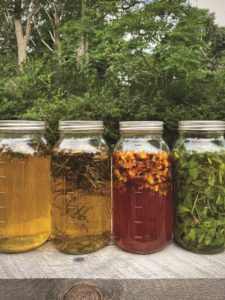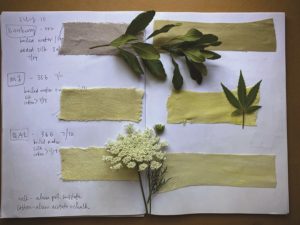Solar dyeing starts with a gathering: deadheaded blooms, freshly unfurled petals, bright green leaves. Dyer’s Coreopsis, Queen Anne’s lace, and Rudbeckia. My garden shears make quick work of the task. Collecting flowers as I move throughout the yard, I drop them into clear glass Mason jars, creating a menagerie of colors.

Before capping the jars, I give the flowers’ previous residents some time to move on — spiders and insects crawl up and out, looking for new digs.
I find a sunny spot outside on the deck to place the jars and their precious cargo. I fill each jar with water, cap tightly, and shake. And then I let the sun work its magic. I watch, and wait a day for the color to develop.
Meanwhile, I prepare a mordant. Mordant means “biting” in French; the mordant allows the dye to bite into the fiber, creating a more permanent color. So, while there’s really nothing to putting together plant-based colors, mordanting is what you need to do to make the colors work as dyes.
The heat created in the jars allows for the release of color compounds found in the plant material, if they are present. Not all plants will produce color, and not all color, once produced, is permanent. Some plant dyes do not need a mordant to bond with fiber — these are known as substantive dyes. Dyes that require a mordant are adjective dyes — their color will fade if no mordant is used. Some plant-based colors are even referred to as fugitive, that is, fleeting. They reveal themselves initially, only to change and fade over time.
Discovering what color each plant will produce is where alchemy meets experimentation.

While the colors emerge, I hunt through closets and drawers for T-shirts, tea towels, and napkins to mordant.
Then, after leaving the flowers and leaves to soak in the sun for a day, I add the prepped fabric, removing plant material to make room, if needed.
I wait a few days. The sun makes a few rounds. And then, the reveal: I uncap the lids and slowly begin the messy task of pulling everything out of the jars. The flowers and leaves can be used again for another round of dyeing, or dried and saved for creating color later on.
I rinse the remaining petals and leaves from my newly transformed laundry pile, and marvel at the deft hands of the sun.
Mordant
needed to prepare your fabric
Fill a bucket with enough water to cover fabric.
Wearing gloves and a mask, add alum (5 to 10 percent of weight of fiber) to a cup.
Slowly pour one cup of boiling water into the alum and stir until fully dissolved.
Pour the alum solution into the bucket and stir thoroughly.
Add fabric and stir.
Soak for 45 minutes, stirring often. Remove and rinse. (Reuse your alum bath multiple times; cover with an airtight lid and store. Or water your acid-loving plants with it.)



